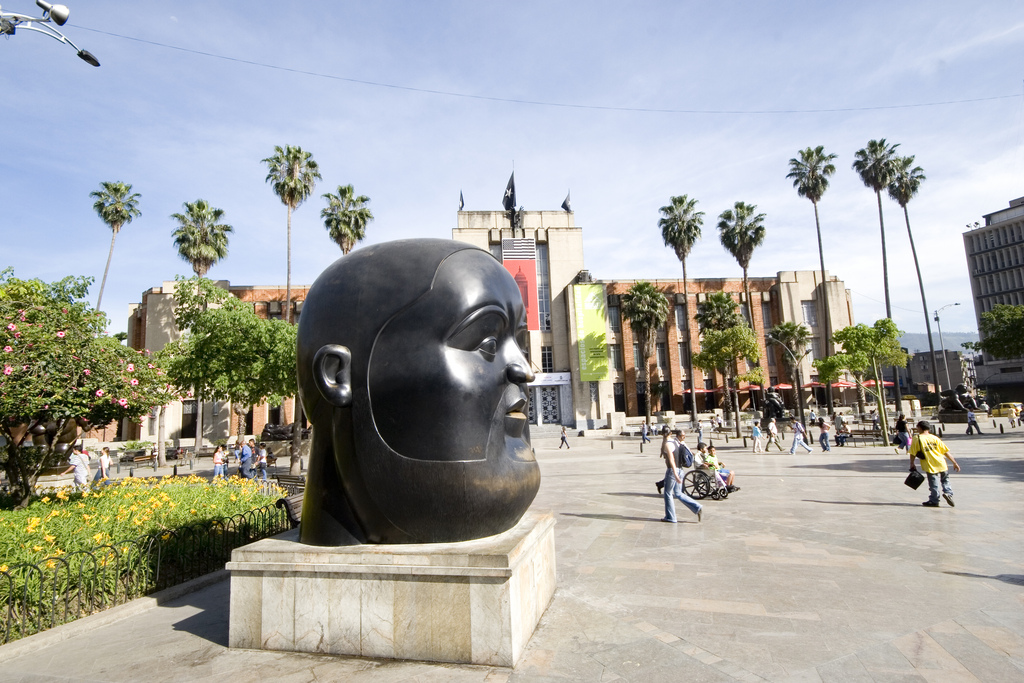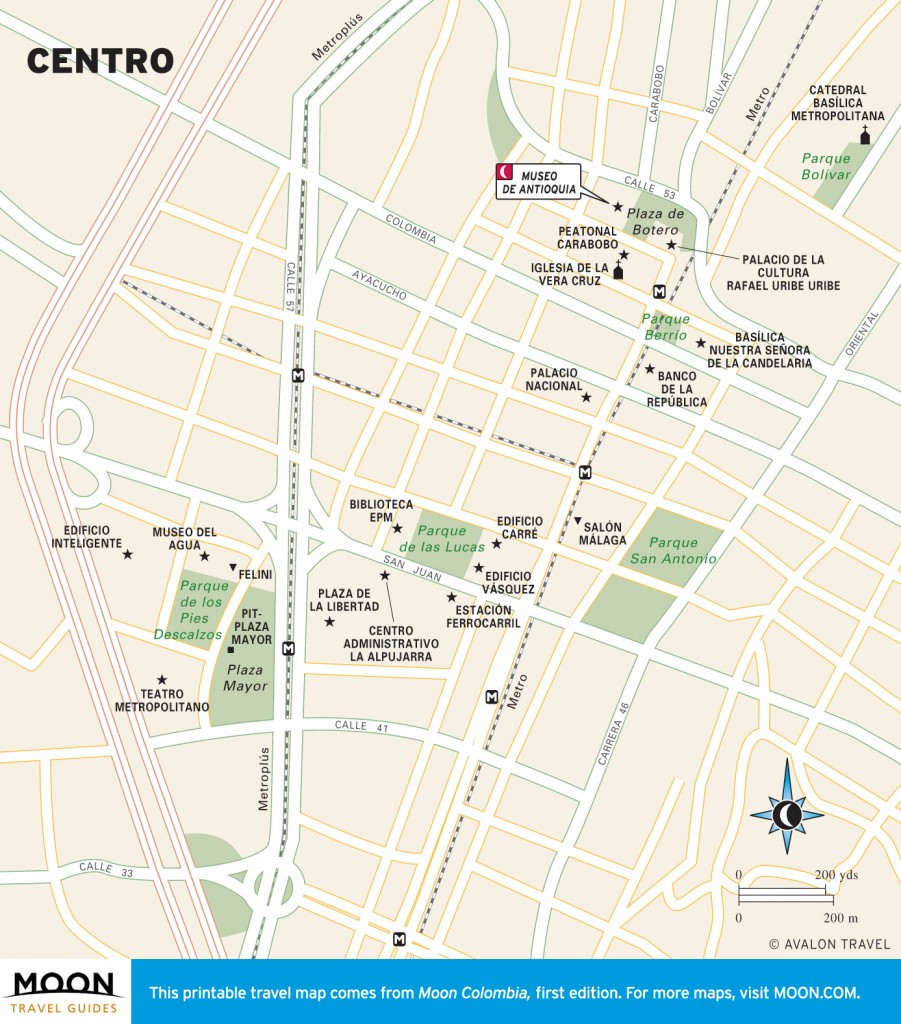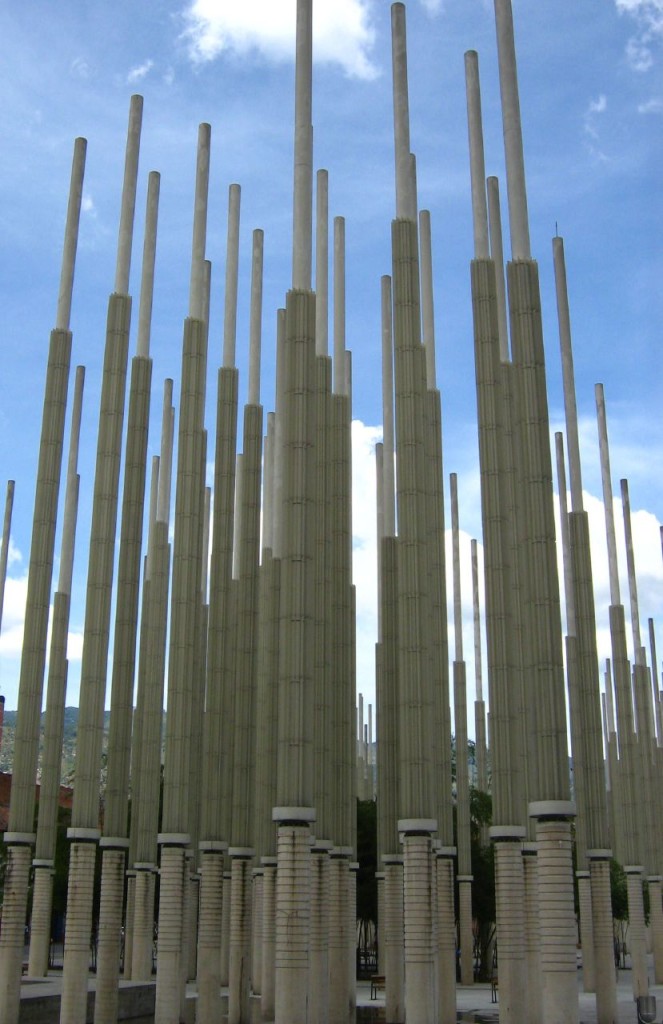Medellín’s brash downtown is a compact history tour comprising stoic remnants from the colonial era, brick and mortar evidence of Medellín’s rising as Colombia’s most important industrial center in the early 20th century, and the vibrant public spaces, modern transportation systems, and futuristic architecture showing this proud city’s 21st-century optimism.
Begin the tour at the Parque Berrío Metro station and walk five minutes north to the Plaza Botero.
Most visits downtown begin under the shadows of the Palacio de la Cultura Rafael Uribe Uribe (Cra. 51 No. 52-03, 8am-5pm Mon.-Fri., 8am-2pm Sat., free), an occasional host of art exhibits. The Plaza Botero (in front of the Museo de Antioquia, Cra. 52 No. 52-43) gets its name for its 23 corpulent bronze sculptures by Fernando Botero. Passersby often pose in front of the sculptures, such as La Mano (The Hand) and Eva (Eve) for a quick snapshot. One of the most prolific, and by far the best known, of contemporary Colombian artists, Botero donated these sculptures to his hometown of Medellín. His paintings and sculptures of rotund people often portray campesino (rural) life, but many of them are also commentaries on the violence in Colombia.

Plaza Botero. Photo © Guía de Viajes Oficial de Medellín, licensed Creative Commons Attribution.
To the south, the Peatonal Carabobo is a pedestrian walkway that extends for eight blocks. Lined with shoe shops, five-and-dime stores, and snack bars, it’s busy, loud, and colorful. (Although there is usually a police presence, be sure to watch your stuff!)
On the right-hand side is Medellín’s oldest church, the brilliantly white Iglesia de la Vera Cruz (Cl. 51 No. 52-38, tel. 4/512-5095), which dates back to 1682. It is often filled with working-class faithful, sitting or standing in meditation and prayer. It’s a refuge of quiet in this busy commercial area. The only other living testament to Spanish rule in Medellín is the white-washed Basílica Nuestra Señora de la Candelaria on the Parque Berrío a few blocks away.

Centro de Medellín
The Belgian architect who designed the grandiose Palacio Nacional (Cra. 52 No. 48-45, tel. 4/513-4422) in the 1920s probably never expected that it would, over time, become the domain of around 400 tennis shoes and jeans vendors. It was originally built to house governmental offices, and today, when you walk through the corridors of this historic building, all you’ll hear is the chorus of “a la orden” (“at your service!”) from hopeful shop attendants. Towards the end of Peatonal Carabobo is Donde Ramón, a small kiosk in the middle of the walkway, jam-packed with antique objects like brass horse stirrups or old carrieles (leather handbags) from Jericó.
After years of abandonment and urban decay, in 2005 the artificial forest of the Parque de las Luces or Plaza Cisneros (Cl. 44 at Cra. 52) was opened in an effort to rejuvenate the area. The park, consisting of 300 illuminated posts, looks somewhat odd during the day but is spectacular at night when it shines. Check it out by car at night as it is not safe to roam about after dark. On the east side of the plaza are two historic early-20th-century brick buildings: the Edificio Carré and Edificio Vásquez (Cl. 44B No. 52-17, tel. 4/514-8200). When they were built they were the tallest buildings in Medellín. These buildings were once important warehouse facilities during the industrial boom of the early 20th century. The plaza used to be the home of the main marketplace. On the western side of the plaza is the Biblioteca EPM (Cra. 54 No. 44-48, tel. 4/380-7516, 8:30am-5:30pm Mon.-Sat.), a stunning public library sponsored by the electric company EPM (Empresas Públicas de Medellín), built in 2005. In addition to reading rooms, there are occasional exhibitions and cultural events held at the library.

Parque De Las Luces. Photo © Luz Adriana Villa A, licensed Creative Commons Attribution.
Across from the Parque de las Luces on the southern side of Calle 44 is the Estación Ferrocarril (Cra. 52 No. 43-31, tel. 4/381-0733), the old main train station. There’s not much to see here, except for a train engine and forgotten old tracks.
To the west of the Estación Ferrocarril is the Centro Administrativo La Alpujarra (Cl. 44 No. 52-165), which houses the Departamento de Antioquia government offices. The sculpture Homenaje a la Raza, by Rodrigo Arenas Betancur, stands in the middle of the large intermediary plaza. Just beyond is the Plaza de la Libertad (Cra. 55 between Clls. 42-44), a complex of modern office space and interesting public space complete with urban gardens.
Cross the pedestrian bridge over the lanes of the Metroplús bus station. Metroplús is the latest addition to Medellín’s transportation network. It debuted in 2013. Here is the Plaza Mayor (Cl. 41 No. 55-80), the city’s preeminent convention and event venue; it has a fair share of nice restaurants. The Teatro Metropolitano (Cl. 41 No. 57-30, tel. 4/232-2858), built from 20th-century brick, hosts concerts.
Finally, the Plaza de los Pies Descalzos (Cra. 58 No. 42-125) is a plaza filled with a guadua (Colombian bamboo) forest and fountains, where you can take off your shoes and play. It’s surrounded by eateries on one side and the massive Museo del Agua (Cra. 57 No. 42-139, tel. 4/380-6954, 8am-6pm Tues.-Fri., 10am-7pm Sat.-Sun., COP$4,000) on the other. In the distance is a long-standing Medellín architectural icon: the Edificio Inteligente (Cra. 58 No. 42-125, tel. 4/380-4411). Built in the late 1950s, it has served as the headquarters of EPM, the utility company. To find out what’s so smart about it, you can take a free tour of the building. They are offered Monday-Friday. Call in advance to reserve.
Excerpted from the First Edition of Moon Colombia.